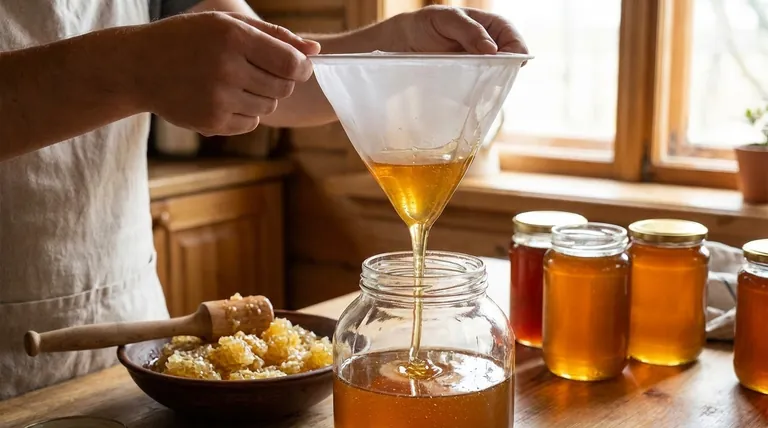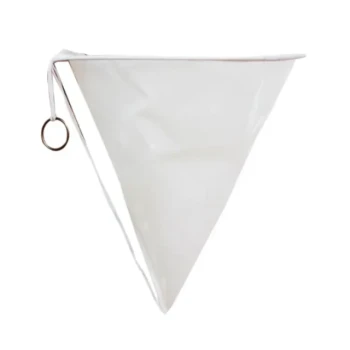At its core, straining honey at home involves the "crush and strain" method. This technique requires you to cut the honeycomb from its frame, crush the comb to break open the wax cells, and then pour the mixture through a series of filters to separate the liquid honey from the solid wax and other debris.
The fundamental goal is simple: physically break open the wax cells to release the honey, then use gravity and a filter to separate the two. You do not need expensive, specialized equipment to produce clean, pure honey in your own kitchen.

The "Crush and Strain" Method Explained
For beekeepers without a mechanical extractor, the crush and strain method is the traditional and most accessible way to harvest honey. It's effective, requires minimal investment, and ensures you can process every last drop.
Step 1: Prepare Your Workspace and Tools
Before you begin, cleanliness is critical. Honey is a food product, so every surface and tool that touches it must be food-safe and spotless to prevent contamination.
You will need a few basic items: a large food-safe bucket for collecting the honey, a second bucket, a long serrated knife, a tool for crushing (like a potato masher or large spoon), and your filters.
Step 2: Cut the Comb from the Frame
Lay your honey frame flat over a clean tray or the collection bucket. Use a long, serrated knife to carefully slice the honeycomb away from the wooden frame, letting it fall into the container below.
Step 3: Crush the Honeycomb
This is the most important step for releasing the honey. Using a potato masher, a sturdy spoon, or even your (thoroughly cleaned) hands, press down and crush the chunks of honeycomb.
The goal is to break the delicate wax structure of every cell. This action, not heat, is what allows the honey to flow freely from the comb.
Step 4: Strain the Honey
Set up a double-straining system for the best results. Place a coarse filter over your clean bucket first to catch large pieces of wax. You can use a standard kitchen colander or a coarse honey strainer.
Once the honey has passed through the coarse filter, strain it a second time through a finer mesh. Nylon straining bags, layers of cheesecloth, or a purpose-made fine honey filter work perfectly. Gravity will do the work, but it can be slow; allow several hours for the honey to drip through completely.
Understanding the Key Trade-offs
While simple, the crush and strain method has implications you should understand. Your choices affect the final product's character and your overall efficiency.
Heat and Honey Quality
Large commercial operations often gently heat honey because it drastically reduces viscosity, making it flow faster. However, for raw honey, avoid applying heat.
Heating honey above hive temperature (around 95°F or 35°C) can destroy the beneficial enzymes and delicate aromas that make raw honey unique. Straining at room temperature preserves this quality, though it requires more patience.
Filtration Level and Clarity
Straining removes beeswax, propolis, and other hive debris. A very fine filter will produce brilliantly clear honey, which is visually appealing.
However, these fine filters also remove most of the pollen. Many people value raw honey for its pollen content, so a slightly coarser filtration might be desirable. A few tiny specks of wax or pollen in your final product are perfectly natural and safe.
Manual Straining vs. Mechanical Extraction
The crush and strain method destroys the wax comb. A mechanical extractor, in contrast, uses centrifugal force to spin honey out of the cells while leaving the comb intact, allowing bees to reuse it.
For a few hives, crushing and straining is perfectly manageable. If you plan to expand your operation, investing in an extractor becomes more efficient in the long run.
Final Steps and Best Practices
Once the straining is complete, a few final actions will ensure your harvest is stored properly and no part of it goes to waste.
Bottling Your Liquid Gold
Let your strained honey sit in the bucket for 24-48 hours. This allows any trapped air bubbles to rise to the surface, where they can be skimmed off before bottling.
Use clean, completely dry glass jars for storage. Even a small amount of water can initiate fermentation. Seal the jars tightly and store them at room temperature.
Don't Discard the Precious Wax
The wax collected in your strainers is a valuable byproduct. It can be washed with water (the runoff makes a great base for mead) and then melted down.
Once melted and filtered again to remove remaining impurities, this beeswax can be used to make candles, furniture polish, lip balms, or lotion bars.
Making the Right Choice for Your Goal
Your ideal setup depends on your priorities for the final product.
- If your primary focus is preserving the most natural, raw product: Use a simple nylon paint strainer or a double layer of cheesecloth to remove large wax pieces while retaining most of the pollen.
- If your primary focus is achieving maximum clarity: Invest in a dedicated, multi-level stainless steel honey sieve that fits securely over a 5-gallon bucket.
By following these straightforward steps, you can confidently and successfully process your own pure, raw honey right from your kitchen.
Summary Table:
| Step | Key Action | Purpose |
|---|---|---|
| 1 | Prepare Workspace & Tools | Ensure food-safe cleanliness to prevent contamination. |
| 2 | Cut Comb from Frame | Remove honeycomb from the wooden frame. |
| 3 | Crush the Honeycomb | Break wax cells to release the honey. |
| 4 | Strain the Honey | Use coarse then fine filters to separate honey from wax. |
Ready to scale up your honey harvest? As HONESTBEE, we supply commercial apiaries and beekeeping equipment distributors with the high-quality, wholesale-focused supplies needed for efficient, large-scale operations. From durable strainers to advanced extraction systems, we provide the reliable equipment that helps your business thrive. Contact our expert team today to discuss your specific needs and discover how we can support your success.
Visual Guide

Related Products
- Professional Cone-Shaped Honey Filter with Reinforced Steel Ring
- Stainless Steel Double Layer Honey Strainer Sieve Filters
- Conical Nylon Honey Strainer Filter Bag for Beekeeping and Honey Filtration
- 10L Stainless Steel Electric Honey Press Machine
- 0.5T Capacity Honey Dehumidifier Dryer with Vacuum Heating and Thickening Filtering Machine
People Also Ask
- What is the role of filtration in honey processing? Ensure Purity, Clarity, and Shelf Life
- What Micron is best for filtering honey? Choose the Right Filter for Show-Quality or General Sales
- Is it necessary to filter honey after extraction? A Guide to Straining vs. Raw Honey
- What is the appearance of filtered honey? A Guide to Clarity, Processing, and Quality
- Why is it important to inspect and replace filters in honey filtering equipment? Protect Your Honey Quality & Equipment



















